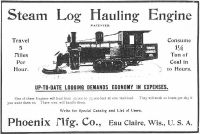
Phoenix Manufacturing Company |
Geared Steam Locomotive Works
©
Hosted by
Sunserver Networks

|
|
|
|
Cross Lake Lumber, Minnesota |
The Phoenix Manufacturing Company of Eau Claire, Wisconsin built geared steam log hauling engines. Except for one known conversion for rail use, the engines were equipped to operate directly on the ground or over snow and ice. It is this rail converted exception that warrant's this company's inclusion on this here-in.
The steam log hauler was not intended for use on rails, but nevertheless was a locomotive in its own right. Real "trains" consisting up to 14 or 16 sleds loaded with logs or forest products were handled regularly by these engines. It was adapted to all northern climates where snow and ice lasted long enough to get the logs out of the woods. Limited use was made of the engines in the summer by substituting wheels in front instead of the runners.
The caterpillar type of drive was the invention of Alvin O. Lombard, a resident of Waterville, Maine. In 1899 a steam engine on continuous treads was built for the Kennebec Lumber Company. It was quite successful; and the Phoenix Manufacturing Company of Eau Claire, Wisconsin, one of the largest manufacturers of saw mill equipment, bcame interested and and secured the rights to build the engines. The caterpillar tread construction was maintained but the method of driving was improved. A typical Phoenix owned by the Park Rapids Lumber Company, Park Rapids, Minnesota, is illustrated from a photo taken in 1906.
(*)The standard Phoenix carried 175 lb. boiler pressure and had two vertical 6 in. x 8 in. cylinders on each side. The caterpillar treads of one side were driven independently of the other so that no differential was necessary. The machine was rated at 100 h.p. at 8 m.p.h. This was the average loaded speed, although a maximum of 12 m.p.h. could be attained; and at this speed with the four cylinders exhausting one would think the engine was making sixty miles an hour.
An iced road was regularly maintained for these engines, and with 14 sleds about 100,000 feet of lumber could be hauled in one trip. The crew consisted of a chauffeur who steered the engine and an engineer, fireman, and brakeman. At points on the roadway where steep descending grades occurred, hay was stored: the brakeman's duty was to throw hay under the runners increasing the resistance of the sleds toprevent the train from overrunning the engine.
To the best of my knowledge, only one Phoenix ever became a genuine railway locomotive. In 1904, the Cross Lake Lumber Company in Minnesota, at its Pine Lake operation, required a switch engine for its logging railway and the photo shows this interesting conversion.
(CrossLake.jpg)All told the Phoenix people built about 200 of their steam log haulers; and in their heyday these engines could be found at work in remote parts of the world, such as Russia and Alaska. In later years the company experimented with a gasoline tractor on caterpillar treads, and a few were made and sold. No further development was made for apparently the Phoenix concern did not foresee what possiblities there were in a mechanism of this kind; 1925 saw the end of this firm.
This page changed July 10, 2005 07:10:22 AM